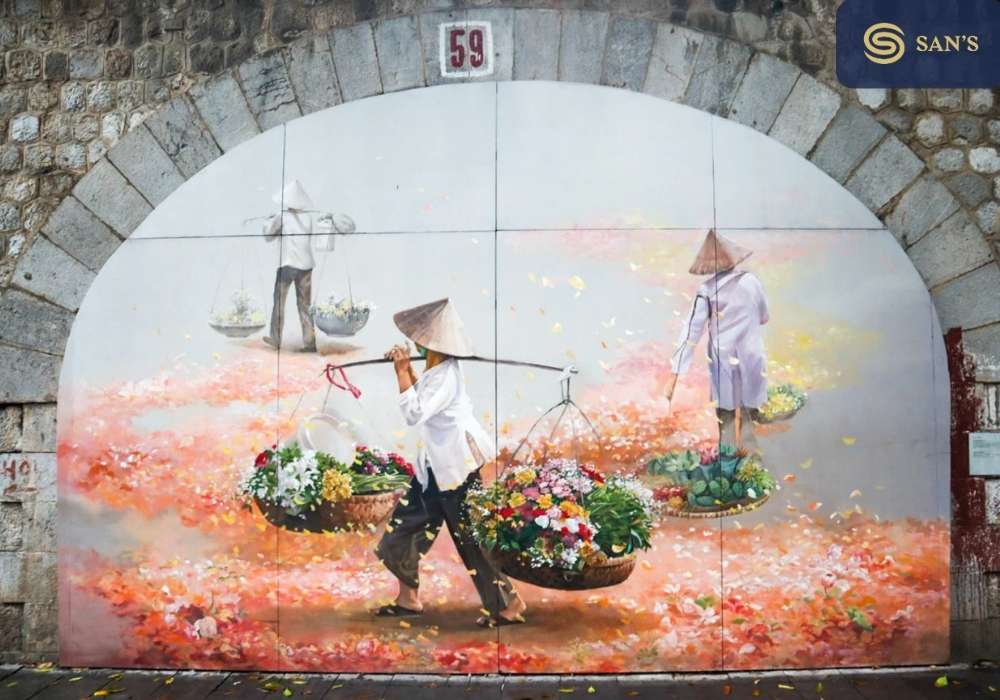Street art in Hanoi isn’t just a visual spectacle; it’s a cultural narrative. Each mural, graffiti piece, and installation tells a story, reflecting the intricate tapestry of a society that’s as diverse as the art it inspires. Visitors flock to the city, not just for its renowned cuisine and architecture but to embark on a visual journey exploring narratives depicted on walls.
For locals, this art form is a source of pride and identity, transforming mundane spaces into galleries of thought-provoking images that touch on themes from history to future, tradition to innovation, realism to abstraction.
-

Street Art in Hanoi
The Evolution of Street Art in Hanoi
Historical Context:
Street art in Hanoi has a rich yet complex history, marked by the city’s shifting cultural and political landscapes. In its nascent stages, this form of art was often a clandestine expression of social sentiment, where anonymous artists used the city’s walls to voice the unuttered. Over the decades, as Hanoi opened its arms to the world, these silent narratives evolved, transforming from obscure doodles into sophisticated murals echoing the city’s soul.
Influence of Global Trends:
As globalization swept through the narrow lanes of Hanoi, international styles of street art seeped into the city’s artistic milieu. Artists from around the world converged in Hanoi, injecting a dose of diverse influences. This cross-cultural infusion enriched Hanoi’s street art scene.
Western graffiti styles amalgamated with traditional Vietnamese aesthetics, giving birth to a unique blend of artistic expression that could only be found on the walls of Hanoi. Street art in the city today is a vibrant testament to this harmonious blend of local and global influences, making every mural a dialogue between the traditional and the contemporary, the indigenous and the foreign.
Notable Street Art Locations
Phung Hung Street Murals:
Nestled in the heart of Hanoi, Phung Hung Street is a vibrant testament to the city’s flourishing street art culture. The walls here are adorned with over a dozen magnificent murals, each echoing tales of the city’s rich history, culture, and daily life.
-

Street Art in Hanoi
Artists, both local and international, have turned this once ordinary street into a dynamic canvas, where art and reality blend seamlessly. Each piece, marked by its unique style and narrative, invites onlookers into a visual journey through Hanoi’s multifaceted identity.
Tam Thanh Mural Village:
Venturing beyond the city’s confines, Tam Thanh Mural Village stands as another emblem of the blossoming street art in Hanoi and its outskirts. This quaint fishing village has transformed into a vivid gallery, with art engulfing every available surface.
-

Street Art in Hanoi
Murals of radiant colors and intricate designs depict the lives and aspirations of the local populace, turning the village into a narrative tapestry of human stories. The transformation has not only beautified the spaces but also attracted a wave of visitors eager to witness this living art exhibition.
The Intersection of Street Art and Hanoi’s Culture
Street art in Hanoi is not just a visual experience but a cultural revelation. Every stroke, color, and mural is imbued with the city’s historical richness and contemporary vibrancy. Artists leverage the city’s walls as canvases to depict folklore, modern-day narratives, and sometimes, a fantastical fusion of both.
This art form isn’t just illustrative but also interpretative, offering insights into the communal, political, and societal ethos of Hanoi’s populace. It stands as a silent storyteller, echoing the unuttered, the celebrated, and the nuanced facets of Hanoi’s cultural landscape.
-

Street Art in Hanoi
Public Perception and Reception
For the locals, every mural is a familiar chapter of a larger narrative, making street art an intrinsic part of Hanoi’s identity. It’s a source of community pride and a testament to the city’s resilience, evolution, and artistic fervor. Tourists, on the other hand, view these artistic expressions as windows into the soul of the city.
Each artwork, with its intricate designs and powerful imagery, serves as a cultural interpreter, offering insights into the city’s past, present, and anticipated future. In this duality of perception, street art in Hanoi transcends visual aesthetics, becoming a bridge that connects diverse onlookers to the city and to each other.
VI. Future of Street Art in Hanoi
Upcoming Trends
The kinetic energy of street art in Hanoi is poised for transformation. Building on a rich tapestry of existing artworks, the future promises an amalgamation of technological integration, mixed mediums, and interactive art spaces. Influenced by global trends, anticipations are high for augmented reality and digital overlays to enhance the physical art pieces.
These innovations will not just accentuate the visual allure but also make the art more accessible, interactive, and engaging. The convergence of traditional art forms with digital innovations is anticipated to redefine the aesthetics and narratives portrayed in the city’s public spaces.
-

Street Art in Hanoi
Challenges and Opportunities
Yet, with innovation comes challenges. Regulatory frameworks, preservation of iconic pieces, and the integration of evolving art forms within the city’s historical architecture are pertinent issues to address. Balancing the sanctity of public spaces with artistic expression and ensuring that the essence of street art remains uninhibited will be crucial.
However, these challenges open doors to opportunities. Collaborations between artists, city planners, and the community can foster an environment where street art not only thrives but also contributes to the city’s cultural, social, and economic ecosystem. Street art in Hanoi, with its dynamic nature, is on the threshold of a renaissance, where it will not just adorn but enliven, engage, and transform public spaces into interactive cultural dialogues.
Street art in Hanoi encapsulates a vivid interplay of history, culture, and artistic innovation, offering both locals and visitors a vibrant visual journey through the city’s evolving narrative. This colorful tapestry, adorning walls and alleyways, isn’t just an aesthetic endeavor but a pulsating reflection of Hanoi’s soul, signaling the city’s unwavering stride from historical richness to contemporary dynamism.
FAQs about Street Art in Hanoi
Q1: Where can I find street art in Hanoi?
A1: Street art can be found throughout Hanoi, with prominent locations including Phung Hung Street Murals and Tam Thanh Mural Village. These places offer a vibrant display of murals and graffiti showcasing the city’s artistic flair.
Q2: Is it legal to create street art in Hanoi?
A2: The legality of creating street art depends on the location and permissions obtained. Always seek approval from property owners or local authorities before creating street art.
Q3: Who are some notable street artists in Hanoi?
A3: Hanoi is home to various talented street artists. While many prefer to remain anonymous, others have gained recognition locally and internationally for their distinctive styles and impactful artworks.
Q4: Can I take a guided tour of street art in Hanoi?
A4: Yes, there are guided tours available that take you through iconic street art spots in the city, providing insights into the art, artists, and the stories behind each piece.
Q5: How has street art in Hanoi evolved over the years?
A5: Street art in Hanoi has transformed from clandestine expressions to celebrated art pieces, influenced by both local cultural nuances and global artistic trends, making the city a dynamic canvas of creativity.
Q6: What themes are common in Hanoi’s street art?
A6: Themes range widely, including but not limited to Vietnamese culture, history, social issues, and the intricate blend of traditional and modern elements that characterize the city.
Q7: How is street art preserved in Hanoi?
A7: Preservation efforts vary. While some artworks are temporary, others are protected and maintained through collaborative initiatives by artists, local communities, and authorities.
Q8: Can visitors create their own street art in Hanoi?
A8: It’s essential for visitors to respect local laws and regulations. Seek permission and collaborate with local artists or organizations to understand the appropriate spaces and methods for creating street art.





